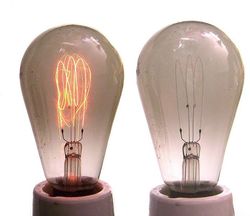Let there be heat! (and light)
 An incandescent light bulb gets hot because
An incandescent light bulb gets hot because
Image credit: Wikipedia Ulfbastel
This section requires Javascript.
You are seeing this because something didn't load right. We suggest you, (a) try
refreshing the page, (b) enabling javascript if it is disabled on your browser and,
finally, (c)
loading the
non-javascript version of this page
. We're sorry about the hassle.
7 solutions
When you flick on a light with a regular incandescent bulb, electricity is converted to heat in the tiny, tungsten wire inside(about 7500 Fahrenheit). At such a high temperature, the energy radiating from the wire includes some visible light. Incandescent light bulbs aren’t the most efficient light source, though, because 90% of the electricity they use produces heat, while a measly 10% produces light.
When the bulb bright Charge electron pass through the filament and lost there energy due to filament this energy is converted into a heat energy. This kinetic energy transmitted to bulb glass.
In these type of bulbs, filaments are covered from oxidation with a vacuum. But it's true that thermionic charges are hitting the inner surface of the glass and it contribute the glass temperature. But actual contribution will be sourced with "radiation" according to law of Stefan - Boltzmann. I think that electrons mean kinetic energy (Boltzmann's constant T) will be so small compared radiation (Stephan's constant T^4). I think all choices are pretty wrong. edit: typing mistakes
why does the answer say giving them kinetic energy , when it bumps into the atoms it gives them heat energy because of the collision
Log in to reply
Because electrons are initially at their respective place. When electricity passaes through filament electrons receives kinetic engergy due to emf n they bumped to the atoms. Some if their energy is transferred to the the other electrons n rest of the energy is dissipated in the form of heat.
i have a doubt in electricity that,when curent flows in cooper wire it takes some electrons from that wire that means some mass of cu wire is missing is it correct karishma mahanta
Log in to reply
The same amount of electrons will be provided by the battery. ..
Electrons on or in the filament rather than electrons of the filament is a more proper description.
It gets hot because it has gained kinetic energy. From where the energy has come from? Of course from the kinetic energy of the electrons
Heat is the measure of total kinetic energy
I got a problem with the term "bump into". it gives the readings that we have enough energy to turn the lamp into a particle collider. What we have is the E&M interaction charges of electrons and atoms transferring energy. Reason that makes CC not suitable for long distance transmission. This interaction and resulting loss in heat we can impedance
Temperature increases coz when the atoms with high kinetic energy strike the glass, energy is dissipated in form of heat
When current is passed electrons gain kinetic energy and when these electrons collide with the atoms of filament the atoms gain energy and hence the atoms start oscillating with a higher amplitude and emits energy in the form of heat.
the electrons collide with the atom of the filament and so these atoms gain energy and then they collide with the surface of the bulb this kinetic energy that converts into heat energy stored on the surface of the bulb this is why the bulb gets heated
"The filament gets an electric charge, so the electrons jump off, hit the glass and heat it." describes a methodology of how fluorescent tubes work; this describes a voltage based methodology. Since other two are further from being reasonable answer, electrons gained K.E. would be the most suitable explanation. The problem is the description of the answer given seem to have raised some confusion.
Incandescent light bulb is a current based light bulb.
The heat is due to the electrons clumsy mistake of bumping into the conductor atoms and by consequence transmitting the atom kinetic energy, basically the more elastic(?) the collision, the more kinetic energy the electron is passing to the atom of the material and the more heat due to atom vibration
The electrons of the filament gain energy when electric current passes through it, so it produces some amount of heat energy which makes the bulb hot.